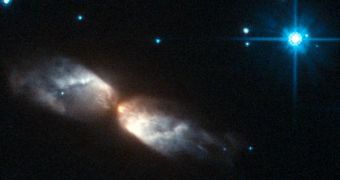Astronomers operating the Hubble Space Telescope managed to capture an impressive new image of a star that is currently dying in the constellation Cygnus. Experts estimate that it will turn into a planetary nebula once it draws its final breath.
According to the new photographs, it would appear that the star, called IRAS 20068+4051, is shedding layers of its atmosphere at a frantic pace, shedding dust and gas clouds in its surroundings.
This is common behavior for celestial fireballs preparing to become planetary nebulae, which are basically emissions nebula that is made up of a massive shell of ionized gas.
The material is ejected as some stars reach the asymptotic giant branch phase pf their development, in which they are classified as gas giants.
Their cores contain carbon and oxygen, and the atmosphere burns helium into carbon, having exhausted the hydrogen supplies for sustaining nuclear fusion.
These processes make the emitted gas shell glow in multiple portions of the electromagnetic spectrum.
Planetary nebulae have nothing to do with planets. The confusion in terms stems from the fact that the early telescopes through which they were first observed made them appear as gas giants.
Experts say that IRAS 20068+4051has yet to turn into a fully-developed nebula. The image shows it in an intermediary stage, and this represents a golden opportunity for astronomers.
Researchers say that continued observations of this structure could yield more insight into the phenomena at work in underlying the evolution and formation of planetary nebulae.
The peculiar, hourglass-shaped gas envelope around the dying star was produced from the originally-spheric gas bubble the stellar atmosphere emitted. Powerful solar winds gave it its current appearance.
Generally, stars in this stage of their life cycle are not readily visible in all regions of the spectrum. Observations are best conducted in infrared light. However, studies cannot be done from Earth.
Our planet's atmosphere absorb a large portion of infrared radiation, and so space-based telescopes have to be used. The Hubble images were collected in yellow (colored blue) and near-IR filters (colored red).
The Advanced Camera for Surveys (ACS) High Resolution Channel was used to capture this amazing new view. Hubble was repaired in May 2009, when the space shuttle Atlantis visited it for one last time, Space reports.

 14 DAY TRIAL //
14 DAY TRIAL //